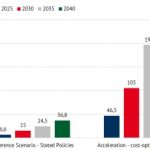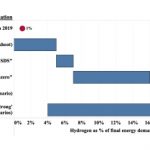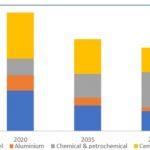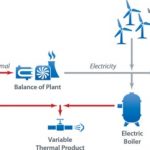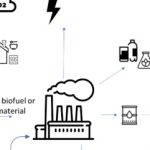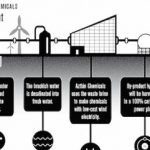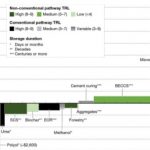Germany is putting in place plans and legislation to launch its green hydrogen economy. Sila Akat and Simon Göss at Energy Brainpool look at the laws and regulations, existing and expected soon, that are driving this game-changing ambition. They have also created five scenarios (two are explained in detail here) for production, based on those plans. The reference “Stated Policies” scenario predicts an increase of electrolyser capacity to 5 GW by … [Read more...]
Saudi Arabia’s clean hydrogen plans for converting ambitions into action
The recent Memorandum of Understanding with Germany on clean hydrogen cooperation underlines Saudi Arabia’s ambition in becoming a global powerhouse producer in this field. Governments and industry players are currently considering clean hydrogen as an energy vector with key energy transition roles in an increasingly carbon-constrained world. Hydrogen has the potential to grow into a trillion-dollar commodity market, with enormous opportunities … [Read more...]
Decarbonising Industry is key to China’s net-zero strategy
China has committed to a CO2 emissions peak before 2030 and carbon neutrality before 2060. It’s 14th 5-year plan will be released in March, followed by sector-oriented plans. For the first time it will include a dedicated plan addressing climate change. Dolf Gielen, Yong Chen and Paul Durrant at IRENA start by laying out China’s energy mix for scrutiny, then dive into its industrial sector which accounts for 60% of gross final energy use. Success … [Read more...]
Nuclear-Wind hybrid plants for grid stability, Power-to-X and more
How would you use a nuclear-wind hybrid plant and maximise its potential? When intermittent wind’s output falls, nuclear can step in to feed the grid. When it’s not doing that it can use its power to run the production of a wide range of commodities: from biofuels, hydrogen, pumped hydro to wastewater purification, desalination, chemical manufacturing and more – including straightforward thermal power for industry. In collaboration with NREL, the … [Read more...]
Bioenergy is the undervalued pillar of the clean energy transition
Bioenergy is already the world’s largest source of renewable energy, responsible for 70% of the supply (and around 10% of total primary energy). Burning organic matter goes back to the invention of fire and is still commonplace around the globe. Yet it gets hardly any of the attention and policy support that’s given to other clean energy technologies like solar, wind and now hydrogen. Bioenergy can and should play an even greater role, explain … [Read more...]
Little progress decarbonising Industry. Renewables can be the answer
The decarbonisation of heavy industry is making little progress. There are two main reasons. Firstly, there are no easy technology wins. Efficiency and carbon capture have been the favoured options. But efficiency gains have their limits, and carbon capture is still proving very expensive. Secondly, governments don’t want their home industries to lose competitiveness incurring costs reducing emissions. Dolf Gielen and Paul Durrant at IRENA say a … [Read more...]
Optimising Cyanobacteria for carbon fixation and biofuels
The landscape can be changed for energy transition technologies by research breakthroughs, and that includes work on bacteria and proteins. The National Renewable Energy Laboratory (NREL) and its partners have been running experiments on cyanobacteria. These single-cell organisms, also using photosynthesis, fix carbon dioxide twice as efficiently as plants. They grow rapidly, doubling their numbers in three hours. The first step is to understand … [Read more...]
“Green” chemical plants that ramp up and down with wind, solar
One solution to variable renewables is to create customers that have no problem with ramping up and down production along with the power. In fact, when the wind and solar is producing too much power for the grid it can be bought very cheaply, making intermittent customers very happy. Jim Conca describes a new design for a Chlor-Alkali Chemical Plant that can “idle” without critical components of the plant degrading – the main reason for a plant … [Read more...]
New EU Industrial Strategy focuses on emissions, but is it enough?
This month the European Commission released its new EU Industrial Strategy to set the direction of travel for the EU economy in the context of the European Green Deal. Energy-intensive industries - like steel, cement, aluminium, paper and chemicals - account for roughly 17% of EU emissions and have struggled to reduce them in recent years. But Johanna Lehne at E3G doubts the strategy is enough to meet the ambition of becoming the first … [Read more...]
10 Carbon Capture methods compared: costs, scalability, permanence, cleanness
We need to understand carbon capture, storage and utilisation (CCUS) better. To do so, this article looks at 10 methods and estimates how much CO2 each will take out of the atmosphere by 2050, and the cost per tonne. In their list the authors, Ella Adlen and Cameron Hepburn at the University of Oxford, cover the industrial (e.g. CO2-EOR, synfuels) to the biological (e.g. forestry, soil carbon sequestration). They say there are six that can be … [Read more...]
“Hard-to-abate” sectors need Hydrogen. But only 4% is “green”
40% of global greenhouse gas emissions come from “hard-to-abate” industry sectors like industrial processing and transport. Electrification won’t be enough. They also need hydrogen, argue Patrick Molloy and Leeann Baronett at Rocky Mountain Institute. Hydrogen production is already well established and growing. But it’s mainly for the chemical industry, which never meant it to be “green”: sure enough, only 4% of current hydrogen production is … [Read more...]


